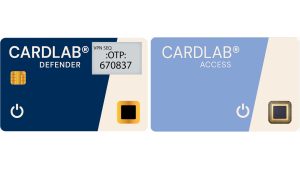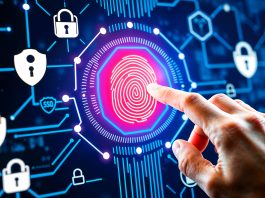CardLab’s biometric authentication system enhances online security by eliminating traditional passwords and enables secure access through unique fingerprint verification, significantly reducing the risk of data breaches and account takeover.
In an era of escalating cyber threats, traditional authentication methods like passwords and PINs are increasingly vulnerable to attacks. A recent case involving the theft of an engineer’s password database has highlighted the risks associated with password-based authentication. Meanwhile, data breach reports indicate a staggering 312%¹ annual increase in data breach incidents that could have been prevented with stronger security measures.
CardLab’s biometric verification and Authentication as a Service provide a cutting-edge solution, ensuring secure access control while mitigating risks associated with centralised password storage, phishing attacks, and stolen credentials. This article explores one real-world use case demonstrating how CardLab’s ‘Authentication as a Service’ solution based on a biometric card can prevent a data breach or account hack.
Understanding the security gap
The traditional approach to digital security relies on passwords, two-factor authentication (2FA), and centralised credential storage. However, this method has inherent weaknesses:
- Weak or reused passwords – Many users rely on simple, repetitive passwords, making them easy targets for brute-force or credential-stuffing attacks.
- Phishing and social engineering – Attackers trick users into revealing credentials, bypassing traditional security barriers.
- Centralised credential repositories – Even password managers, while offering enhanced security, can be compromised, providing an opening for an attacker to gain access to the encrypted vault or backup files.
- SIM swap and OTP bypass – SMS-based 2FA and even app-based authentication can be intercepted and circumvented through social engineering or malware attacks.
The solution? A complete offline biometric user verification on an offline, user-controlled verification device that does not rely on stored passwords or centrally stored biometric data. In addition, tokenisation of the user identity, once verified, ensures that no personal data can be extracted from a ‘man in the middle attack’ or lost or an employee releases a set of passwords by mistake. Static passwords no longer exist in the CardLab setup, and what doesn’t exist cannot be lost or copied.
How CardLab’s biometric system and card works
CardLab’s biometric ‘Authentication as a Service’ solution based on a biometric smart card, is designed to provide high-security user verification for both physical and logical access. It verifies user identity offline, against a fingerprint stored securely on the card itself, never transmitting biometric data over a network. When the user is verified, the card creates a token for online use. The token is used in a verification process in the backend before allowing access to the desired application. This decentralised approach with offline user verification and tokenisation ensures maximum security and privacy.
The sensor on the card, by Fingerprints, offers a robust solution to data breach problems through biometric authentication. By utilising unique fingerprint patterns, the sensor ensures that only authorised individuals can access sensitive information, significantly reducing the risk of unauthorised access and data breaches. Unlike traditional passwords, which can be easily shared or stolen, biometric data is unique to each individual and cannot be replicated or transferred. This non-transferability adds an extra layer of security, making it much harder for malicious actors to gain access to protected systems. Additionally, their sensor’s advanced encryption technology further safeguards user data, ensuring that it remains protected at all times. With its fast and reliable performance, Fingerprints’ sensor not only enhances security but also improves usability, allowing for convenient and secure access to physical and digital systems.
Utilisation
Here’s how the CardLab card can be used to prevent an account hack or data breach:
- User enrolment and setup
o The user registers their fingerprint directly on the card via the on-card fingerprint sensor.
o The biometric data is securely stored within the card’s secure memory and cannot be extracted or cloned.
o The card does not require an internet connection for enrolment, eliminating exposure to remote hacking attempts and side channel attacks during this potentially vulnerable phase.
- Secure user verification on the card
o When accessing an online service (e.g., cloud storage, corporate intranet, or a banking portal), the user presents the card to a compatible NFC or Bluetooth reader.
o The system prompts the user to place their finger on the card’s fingerprint sensor.
o If the fingerprint matches the stored template, the card confirms the user’s identity internally.
o This step occurs offline, ensuring biometric data never leaves the card.
- Authentication on the backend
o Once the card verifies the user, it generates a token/cryptographic signature unique to the authentication request.
o This signature is sent to the service provider for backend authentication, completing a secure passwordless login.
o A connection is required at this stage to communicate with the authentication server. The connection can be via contact chip, NFC, BLE or manual using information shown on the Defender card display.
o CardLab’s QuardLock backend is available to provide this Authentication as a Service.
- Replacing Vulnerable Password-Based
Authentication is a key element to increase data security, and with the CardLab verification and authentication solution, the following advantages are achieved:
o The user no longer needs to remember or enter passwords.
o Even if an attacker steals a user’s laptop or smartphone, they cannot log in without the card and the correct fingerprint.
o Unlike password managers, which store and autofill credentials, the card itself acts as the only verification mechanism.
o The user always has a login device – the use of Smartphones is often restricted or prohibited due to espionage and security concerns.
- Physical access and multi-use security
o The card can also be used for building access control, ensuring only authorised personnel enter restricted areas.
o The same verification mechanism applies, requiring both the physical card and biometric verification for entry.
o Organisations can integrate the card into existing access control systems without additional infrastructure changes.
- Protection against phishing and credential theft
o Unlike traditional authentication methods that rely on user input, the biometric card does not expose credentials to phishing attempts, as it operates totally offline during user verification.
o Even if an attacker tricks the user into visiting a fake login page, the card will not transmit reusable credentials. Every login will require a new token to be accepted.
o Since authentication is cryptographically linked to the service, attackers cannot intercept or replay login data, and even if they could, it would be of no value as it is tokenised data that cannot be reused.
- Decentralised security and data privacy
o No biometric data is stored on external servers or transmitted during verification, reducing exposure to mass data breaches and loss of credentials and associated critical biometric data.
o The card operates independently of cloud-based authentication services, preventing unauthorised access even if backend systems are compromised.
o Unlike SIM-based authentication, the card cannot be hijacked via SIM swap fraud.
Use case: Preventing an enterprise data breach
Imagine a multinational corporation, Healthcare platform, government office/ institution, law firm, bank or similar enterprise that manages sensitive customer/client information, proprietary research, operation of critical infrastructure, etc. These actors previously relied on password-based logins and SMS-based 2FA but faced an increase in phishing attempts and credential theft.
Before implementing CardLab’s Biometric Card:
- Employees typically reused passwords across multiple accounts.
- In a recent, well-publicised phishing attack², an employee was successfully tricked into revealing their login credentials, granting attackers unauthorised access to confidential files or injection of malware.
- Despite having an OTP-based 2FA system, an attacker executed a SIM swap attack, bypassing SMS authentication.
Had this organisation Implemented CardLab’s Biometric authentication solution:
- Employees could only verify their identity using their fingerprint-stored biometric card, making passwords dynamic and saving IT cost on password maintenance.
- Even if an attacker obtained an employee’s login credentials, they would not be able to access the account without the biometric card.
- Phishing attacks would become ineffective, as authentication is tied to the cryptographic proof generated by the card.
- The organisation would significantly reduce security breaches and improve regulatory compliance.
- The organisation could combine the tokenised login with a requirement for tokenised verification of the user before enabling any encryption of data or computer systems. This would block malware and ransomware attacks.
Conclusion: The future of secure verification and authentication
Cybersecurity threats will continue to evolve, but CardLab’s Access and Defender series of biometric smart cards provide a future-proof authentication solution by eliminating the risks associated with passwords and central credential storage. By ensuring that user verification occurs entirely offline on the card and authentication happens securely on the backend, users and organisations gain enhanced security, convenience, privacy, and saved IT costs in an increasingly digital world.
With widespread adoption, biometric smart cards can effectively eliminate data breaches and account hacks and takeovers, offering a highly secure alternative to traditional authentication methods. For enterprises, governments, and individuals, CardLab’s solution represents the next step in secure identity verification, ensuring that only the rightful owner has access to critical systems and sensitive data.
References
- https://www.databreachtoday.com/312-surge-in-breach-notices-that-could-have-been-prevented-a-27397?rf=2025-01-30_ENEWS_ACQ_DBT__Slot1_ART27397&mkt_tok=MDUxLVpYSS0yMzcAAAGYV0bFSCKDaGMOgmj160CJsmfg6xgTrsZtboH13nMzMMd-3vUYf4JXxb2v7rWFS7_1QYZLzwylxPXbXOG9DTSJl-MsFRawPbLMCcDzOs874ZX_ZArq2Q
- https://www.zdnet.com/article/hackers-stole-this-engineers-1password-database-could-it-happen-to-you/?utm_source=Iterable&utm_medium=email&utm_campaign=campaign_12746109
Please note, this article will also appear in the 22nd edition of our quarterly publication.












